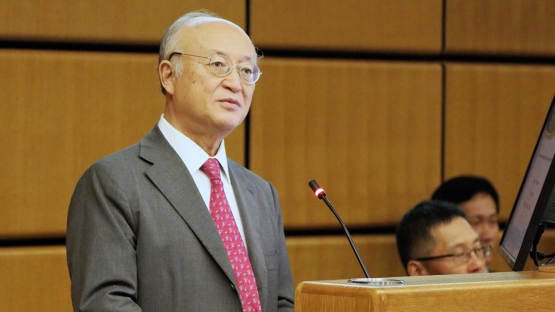Innovation in the nuclear sector is vital to fulfil its potential in combatting climate change, agreed panellists at a side event held on the margins of the IAEA General Conference today. The side event ‘Nuclear Energy Innovation and the Paris Agreement’ identified the linkage between the future of nuclear power and how it can be incorporated into national climate action plans to support the reduction of carbon emissions worldwide.
Ambassadors, Member States representatives, senior officials from international organizations and industry experts took a closer look at deployment of nuclear energy innovations that can support the reporting of countries’ five-year Nationally Determined Contributions (NDCs) under the Paris Agreement on Climate Change.
Adopted in 2015 by world leaders, the Paris Agreement has set a new course at holding the increase in global temperature to below 2°C. All low-carbon energy technologies, including nuclear power, are needed to meet the Paris Agreement goal.
“It is timely that we highlight the role of nuclear power in reducing environmental impacts, particularly CO2 emissions,” said Yukiya Amano, IAEA Director General, at the event. “Innovations in nuclear technologies can significantly help global climate efforts. When countries update their NDCs, they should consider the evolving role of nuclear power in their low-carbon energy mix to replace high-carbon sources.”
Delegates at the side event discussed how countries can accelerate the development and deployment of nuclear energy. Speakers introduced delegations to some nuclear technology innovations currently under development.
“There are a number of advanced nuclear power technologies such as accident tolerant fuels, High Temperature Reactors, Small Modular Reactors (SMRs), non-electric nuclear applications and innovative nuclear systems with great potential for enhanced competiveness and sustainability, as well as make substantial contributions to greenhouse gas emission reduction,” said Stefano Monti, Head of the IAEA Nuclear Power Technology Development Section.
“Some are ready or almost available for deployment, while others are at very different stages of development, from pre-conceptual design to detailed design and demonstration,” he explained.
Participants learned that innovations in nuclear energy can help maintain nuclear’s low-carbon energy share and support new roles in the replacement of high-carbon energy sources.
Once they are commercially available, these technologies can be incorporated into country updates of their NDCs.
While looking closely into conditions for advanced nuclear technologies to be accelerated, industry leaders emphasized the importance of investment in research and innovation. Further corresponding conditions were identified as simplification of the regulatory framework, enhanced infrastructure, public perception and support.
“These key factors are imperative to meet the increased levels of ambition needed to achieve the Paris Agreement goal,” said William Magwood, Director General of the Nuclear Energy Agency (NEA). He presented NEA’s initiative known as ‘Nuclear Innovation 2050.’
As the global need for the development of next-generation advanced technologies grows, the NI2050 focuses on the potential of nuclear fission technology defining main priority areas and topics where the R&D is necessary to push for innovation.
“Multilateral approaches can create the confidence needed for a worldwide deployment of innovative technologies,” he said in his keynote speech. “All stakeholders, in particular the science, industry and regulatory communities – each with their specific competencies and responsibilities – need to be part of a renewed innovation process through early involvement and continued interaction,” he outlined.
In this regard, the Agency has capacity to help Member States evaluate their energy plans and inform them of innovative nuclear energy technologies that can mitigate carbon. The Head of the IAEA's Planning and Economic Studies Section, David Shropshire explained that carbon reduction can be achieved by extending the operation of existing nuclear power plants, filling growing country energy demands by using increasingly efficient nuclear reactor designs.
With this knowledge, Member States may choose to include new nuclear technologies in the updates of their NDCs. The Paris Agreement stipulates that NDCs will be progressively revised every five years starting from 2020.
In 2018, countries will begin taking stock of their collective efforts in relation to the progress made towards the goal set out in the Agreement.



